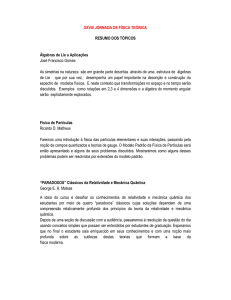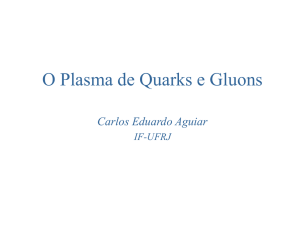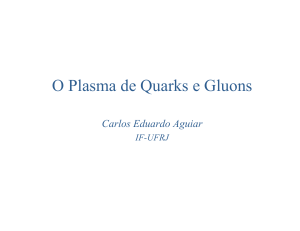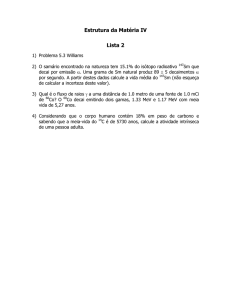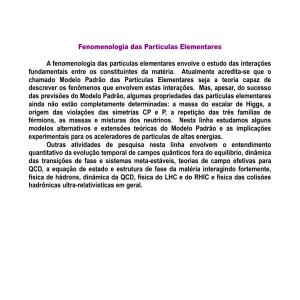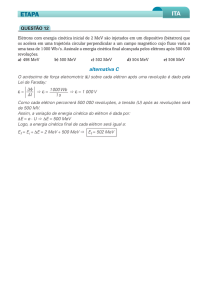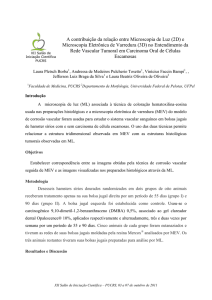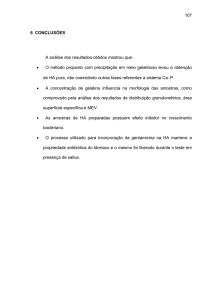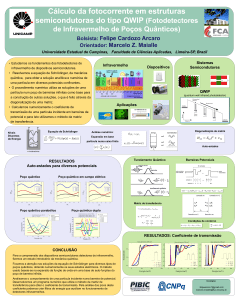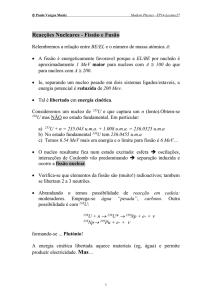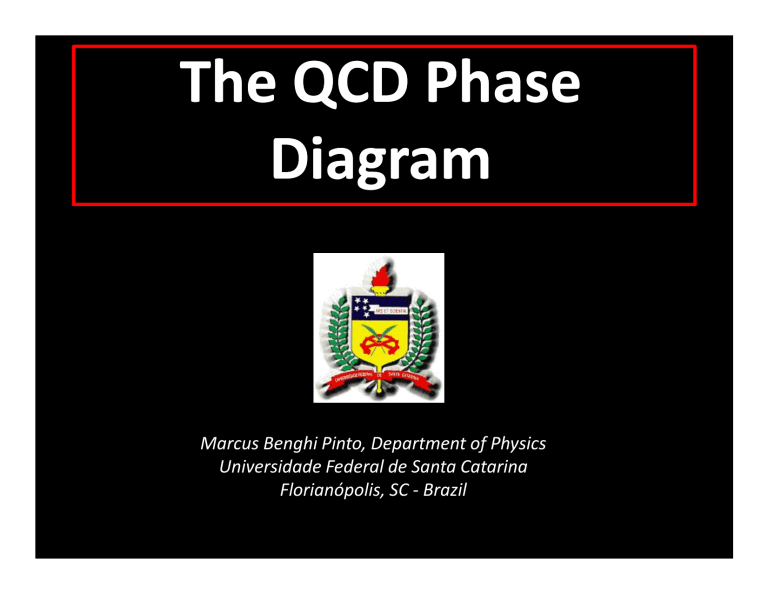
The QCD Phase
Diagram
Marcus Benghi Pinto, Department of Physics
Universidade Federal de Santa Catarina
Florianópolis, SC - Brazil
Força Nuclear Forte (Rutherford):
Minha experiência sugere que o átomo é composto
por um núcleo positivo extremamente massivo em torno
do qual os elétrons orbitam. O núcleo possui partículas com
carga elétrica positiva (protons: p) e zero (neutrons: n). No futuro
n e p serão chamados nucleons
nucleons.
O problema
problema: no curso de Física Geral III aprendi que cargas de
mesmo sinal se repelem!! Como explicar a estabilidade do
núcleo? Sugiro a existência de outro tipo de interação, capaz de
vencer a repulsão elétrica mas só na região bem pequena
(~10-15 m) que caracteriza o núcleo.
Agora vejo que aquilo que chamei de partícula α é na verdade
um núcleo de He.
1919: nasce a Física Nuclear com sua interação forte.
Hideki Yukawa,
Yukawa, Nobel 1949
1934: nucleons (fermions de massa ~ 1GeV)
interagem através da troca de
mésons π (bósons de massa ~ 0.14 GeV)
1947: mésons π detectados
Occhialini, Powel & Lattes
por Occhialini,
N
π
N
π
k
N
N
N+N à N+N
2) As Partículas Elementares
DISTÂNCIA
ENERGIA
HADRONS:
Fraca + EM
Meson
(quark-antiquark)
NuclearForte +
LEPTONS:
Fraca+EM
Barions:
3quarks
3) Teorias de Calibre: QED, QCD & QFD
RELATIVIDADE RESTRITA + MECÂNICA QUÂNTICA
Eletrodinâmica Quântica: QED
(Teoria Quântica para Campo Eletromagnetico)
James Maxwell: minhas equações para o
campo Eletromagnético já nasceram
com a grife relativística: c=1/÷(mo eo)
Eu uso linhas de força em minha
Eletrodinâmica Clássica (CED).
Busquei uma teoria com as grifes:
Relativística (c) e Quântica (h).
Eu tenho quanta em minha
Eletrodinâmica Quântica (QED).
Estes quanta são os FÓTONS
(este aí é virtual).
Princípio de Gauge (Ward & Salam):
Só fermions LIVRES de massa m
U(1), Abeliana
Temos:
Pode
Somar:
onde
Componentes são campo E+M
y: férmions (elétrons, quarks) ; A: campo EM -> fóton
M
NÃO pode haver termo de MASSA para
Campo A (fótons): VIOLA Inv. de GAUGE
QED: calcular com teoria de Perturbação processos físicos como
e+eÆe+e
LABORATÓRIO
Fótons e pares (eletron/positron)
virtuais
(QED – uma teoria possível)
Cromodinâmica Quântica: QCD
Oh man
man,, quarks
have color & flavor
flavor,,
thats awesome BUT
what about
FREEDOM?
QED π QCD :
1) QED: 1 carga (elétrica)
QCD: 3 “cargas” (cor)
2) QED: Fóton carga nula (Abeliana)
QCD:Gluons: carregam carga
(INTERAGEM, não Abeliana)
Liberdade assintótica
Anos 70
3) QED: acoplamento fraco: Teo Pert OK!
QCD: acoplamento forte em baixas
Energias (ou temperaturas) !
k(T>Tc)
(QED)
(QCD)
q
QED
r
q
QCD
r
Evidencia EXPERIMENTAL: PARTONS em DIS (Deep
(Deep Inelastic Scattering
Scattering))
INTERAÇÕES FUNDAMENTAIS & “CONSTANTES” (?!) de ACOPLAMENTO
G … SU(3) x SU(2) x U(1) Æ SU(3)xU(1)
Liberdade assintótica
Gross-Wilczek –Politzer
Nobel 2004
Unificação EW
Weinberg – Salam-Glashow
Nobel 1979
Variação com Temperatura îHistória Térmica do Universo: COSMOLOGIA!
Quais as transições esperadas?
Simetria Quiral: tem a ver com a massa
Helicidade (quiralidade aparente):
Mão direita
Mão esquerda
QUAL a MASSA do QUARK? Neste caso a massa efetiva é
Meff ~ Mproton/3
Então Meff = 330 MeV QUANDO confinados em um
HADRON mas e livres? A massa nua , mq, é dada por
Vida real:
real mp = 135 MeV
fp = 93 MeV e s= (250 MeV)3
=> mq ~ 5 MeV
Assim, aumentando TEMPERATURA e/ou DENSIDADE:
1) “Transição” de Fase Quiral:
Quiral:
Massa de 300 MeV
5 MeV (up
up,,down)
down)
2) Transição Fase Confinada
Fase Desconfinada
T
?????
?????
?????
m ~ p - Ap
Estudar a QCD em regimes de altas Temperaturas e Densidades:
Implicações para Cosmologia (universo primordial) e Astrofísica Nuclear
(objetos compactos como Estrelas de Neutrons). Como fazer?
LABORATÓRIO (RHIC e LHC) colidir núcleos pesados em alta velocidade
Teoria:
1) QCD ou seus modelos efetivos
2) Mecânica Quântica + Relatividade Especial + Mecânica Estatística
3) Técnicas NÃO perturbativas: campo médio, Hartree-Fock
Monte Carlo (simulação numérica na rede) => Equação de Estado
Temperature Scales
Room temperature: 25 meV
Core temperature of sun: 1.3 keV
Temperature reached in supernova: 30 MeV
Temperature of universe 1 µs after big bang
when quarks and gluons coalesce into hadrons:
160 MeV
• Temperatures achieved at RHIC and LHC:
400 to 600 MeV
•
•
•
•
Density Scales
• Ordinary matter: 1 to 10 grams/cc
• Core density of sun: 150 grams/cc
• Density of atomic nucleus: 2 x 1014 grams/cc
or 0.15 nucleons/fm3 or 0.14 GeV/fm3
• Core density of neutron star: 1 GeV/fm3
• Density of universe 1 µs after big bang when
quarks and gluons coalesce into hadrons:
1 GeV/fm3
• Densities achieved at RHIC and LHC:
40 to 150 GeV/fm3
BASIC IDEAS from CLASSICAL PHYSICS
m ~ Na - Nb
“Introducing the notion
of effective mass via
Newton’s 2nd law”
MBP in Eur. J. of Phys.
28, 171 (2007)
WHAT DO WE NEED TO STUDY PHASE TRANSITIONS
Statistical Mechanics, the Free-Energy
QFT, the Effective Action: generates ALL 1PI Greens functions
2nd ORDER PHASE TRANSITION & XX-OVER
REMEMBER:
2nd Order
mc = 0
REAL WORLD: mc π0
Chiral Symmetry
NOT EXACT !!!
Tpc
Tpc
Tc
In summary,
summary, the situation is similar to the one found in a ferromagnet:
ferromagnet:
Magnetization analogue to quark condensate (which leads to quark effective mass
mass))
Background magnetic field analogue to current quark mass:
mass:
switches 2nd order to X
X--over
SMOOTH
Tc
1st ORDER PHASE TRANSITION
Familiar water into vapour: violent, latent heat, bubble formation,
metastability, spinodal lines, coexistence regions, etc
RELEVANCE: NEUTRON & QUARK STARS (surface tension)
QCD at low T and high baryonic density
Assinaturas das Transições
X-OVER
X-OVER
1ª ordem
Phase Diagram
2nd Order
mc = 0
1st order
TRICRITICAL
In the REAL WORLD mc π 0 !!
And 2nd ORDER becomes X-over
TRIcritical Point becomes Critical Point
(Theoretical)
Theoretical) QCD Phase Diagram
Only sure about X-over at about T=170 MeV and m=0
=0..
from LATTICE. At mπ
mπ0
0 PD obtained with effective models
for QCD like LSM, NJL etc
O Diagrama de Fases mais básico: obtido com modelos efetivos
Tipo Nambu—Jona-Lasinio e Modelo Sigma Linear
Plano Temperatura vs Densidade Bariônica
Compilation of freezeout conditions
from the SIS, AGS, SPS and RHIC.
WHY MAGNETIC FIELDS ??
NON central HIC
eB ~ 5 – 15 mp2 ~ 1019 G
MAGNETARS
eB ~ 0.5 mp2 ~ 1017 G
1 MeV 2 ~ 1013 G
e= 1 /÷137
- Non-renormalizable since G : 1/(eV) 2 => cut-off
(new:
“parameter”)
- mc =0 => Chiral Symmetry dynamically broken by G > Gc at T=0, m=0
- STANDARD PARAMETRiZATION:
gives
The three flavor NJL effective model for quarks
where
Parameters as two flavor case plus:
The NJL PRESSURE in the MFA (aka
(aka large Nc)
(self consistent)
Effective Mass:
MODIFIED FEYNMAN RULES to ACCOUNT
T , m and B.
FOR:
QM: motion in the x-y plane quantized in units of 2qB due to field
along z.
Levels for which the values of p_x^2+p_y^2 lie between 2qnB and
2qB(n+1) coalesce in single level characterized by n. Must sum over n:
Landau Level
After that we get the explicit relations :
Also:
We’re all set now !!
MAGNETIC CATALYSIS at T = 0 and m = 0
RHIC
LHC
NJL : B stabilizes vacuum chiral asymmetry
favoring qbar-q pair formation opposite to:
BCS : B alignes electronic spins breaking ee pairs
TWO FLAVOR
T = 0 , 1st order
& oscillations LL
m = 0, Xover
- Tpc increases at m = 0
- Tc decreases at high m
- CP at higher T and
lower m
- Size of 1st order line
increases with B
SPINODALS
& METASTABILITY
REGION
Gabriel Ferrari, André Garcia & MBP; PRD (2012)
Coexistence
region
m=0
THREE FLAVOR:
Strangeness is important for the
QCD-PD & for Astrophysics
As 2 flavor case:
- Tpc increases at m = 0
- Tc decreases at high m
- CP at higher T and
lower m
- Size of 1st order line
increases with B
- Also
1st order oscillates for
very high fields
S. Avancini, D.P. Menezes, MBP &
C.Providencia ; PRD (2012)
ASTROPHYSICAL CONSEQUENCES at T=0
EoS becomes
harder with increasing B
Higher stellar masses
with increasing B.
S. Avancini, D.P. Menezes,
MBP & C. Providencia
PRC80, 065805(2009)
LATTICE RESULTS at m=0
M. D’Elia, S. Mukherjee & F. Sanfilippo
arxiv: 1005.5365 [hep-lat]
Nf=2, large a & high mp
OPEN PROBLEM :
Fodor’s Group
Arxiv: 1111.4956 [hep-lat]
Nf=2+1, extrapolation to continuum
& physical mp
CONCLUSIONS
At m=0 Tc INCREASES with B as in most models but contrary to recent
Lattice simulation by Bali et al (1111.4956 [hep-lat]).
G(B) doesn’t alter MC in the NJL (see 1203.4330 [hep-ph])
Open question...
For moderate m, Tc DECREASES with B due to LL.
“Size” of 1st order line INCREASES with B and so does the coexistence
region: astrophysical consequences for quark star formation??
At low T, mc OSCILLATES around the B=0 value for 3 flavors.
Critical chemical potential value first decreases then increases
for very high B.
Same qualitative behavior of our 2 flavor NJL was recently observed
Within the LSMq by Andersen & Tranberg (1204.3360 [hep-ph])
Collaborators::
Collaborators
2André F. Garcia (PhD, UFSC); Juan Camilo Macias (MSc, UFSC); Gabriel N. Ferrari (PhD, UFSC)
& Robson Z. Denke (PhD, UFSC)
Débora P. Menezes & Sidney S. Avancini - UFSC
Constança Providência – Coimbra
Rudnei de Oliveira Ramos – UERJ
Jean-Loïc Kneur – Montpellier
Jorgen Randrup & Volker Koch – LBNL, Berkeley
SPONSOR:

